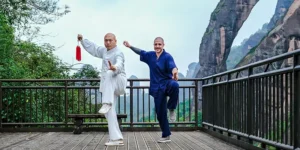If stress makes you feel anxious, tense, and worried, try meditation. Even if you practice it for just a few minutes, meditation can help you regain a calm and peaceful state of mind. Anyone can practice meditation. It’s simple, easy, and low-cost. Nor does it require any special equipment.
You can practice meditation anywhere. You can meditate while you’re out taking a walk, riding the bus, waiting at a doctor’s office, or even in a business meeting.
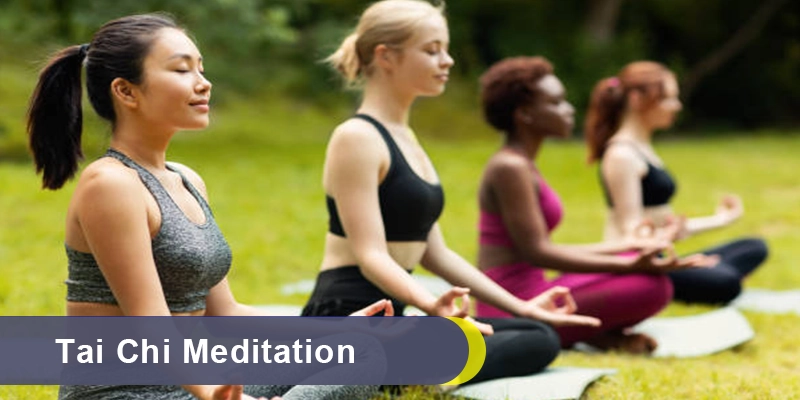
Tai Chi meditation can remove your stress and create inner peace. Learn about Tai Chi meditation, its benefits, types, components, and practice methods to help you relax when you need it most.
Tai Chi meditation is a mindful practice that combines Taijiquan and meditation to relieve stress, mental clarity, and energy cultivation. Chi meditation combines physical movement, breath control, and focused awareness to harmonize the body and mind.
Learn About Tai Chi Meditation
Tai Chi meditation involves gentle, continuous motions derived from traditional Tai Chi forms. These movements are to be smooth and circular, promoting relaxation and balance. Practitioners make deep breathing with movements, enhancing focus and Qi. And meditative practice is a calm, present-moment awareness similar to mindfulness or Zen meditation.
Tai Chi meditation is to achieve the state of “movement and stillness.”
Tai Chi Meditation Benefits
Chi meditation not only balances and flexes your body, but it also keeps you calm and peaceful. Its practice can help you with physical and mental health, and here is an overview of its benefits:
Meditation And Emotional Benefits
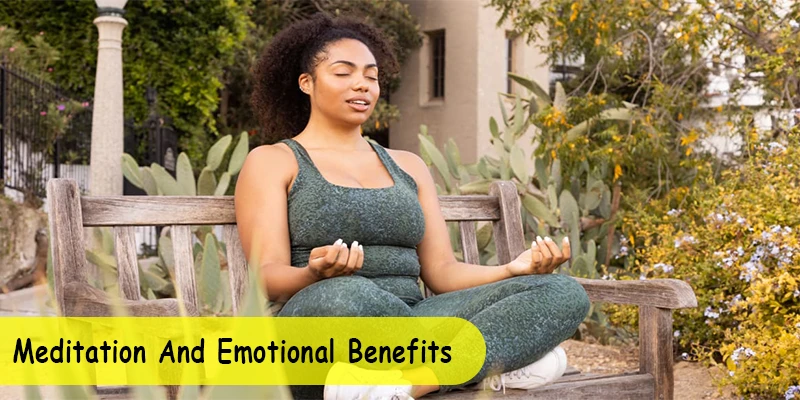
You can relieve stress by practicing meditation. The benefits of meditation for the mind and emotional include
- Reduce Stress And Anxiety
- Meditation combines mindful breathing and movement to lower stress hormone levels. A meditative state calms your mind and fosters emotional resilience.
- Improve Focus and Cognition
- The precise movements and regular breath improve focus and mental clarity. It can slow down cognitive decline by stimulating nerves.
- Adjust Emotions
- Releases endorphins and serotonin, combating depression and promoting a sense of well-being.
- Better Sleep
- Relaxation techniques can improve sleep and help people who have insomnia or restless sleep.
Meditation And Physical Benefits
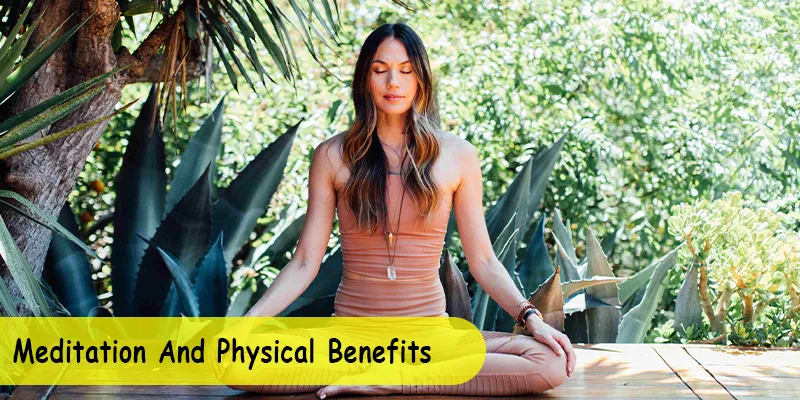
Numerous studies show that meditation has health benefits:
- Improved Balance
- Slow, controlled movements strengthen core muscles and enhance body awareness, reducing fall risks, especially in older adults. Studies show Tai Chi can improve balance in people with Parkinson’s or arthritis.
- Flexibility and Joint Health
- Gentle stretches and flowing motions loosen muscles and joints, promoting easy mobility.
- Enhanced Cardiovascular Health
- Low-impact aerobic exercise improves circulation, lowers blood pressure, and may reduce the risk of heart disease.
- Pain Relief
- Relieves chronic pain (e.g., lower back pain, osteoarthritis) by reducing inflammation and improving posture.
- Boosted Immune Function
- It is believed that reducing stress and improving the flow of energy (chi) can strengthen the immune system.
Chi Qigong Meditation
“Tai Chi Qigong Meditation” is a holistic practice that combines three ancient Chinese practices—tai chi, qigong, and meditation.
Tai Chi is a gentle Chinese martial arts training that requires slow, graceful completion of a series of postures and movements; Qigong balances the body through breath control, movement, and visualization; meditation is a focused practice to calm the mind.
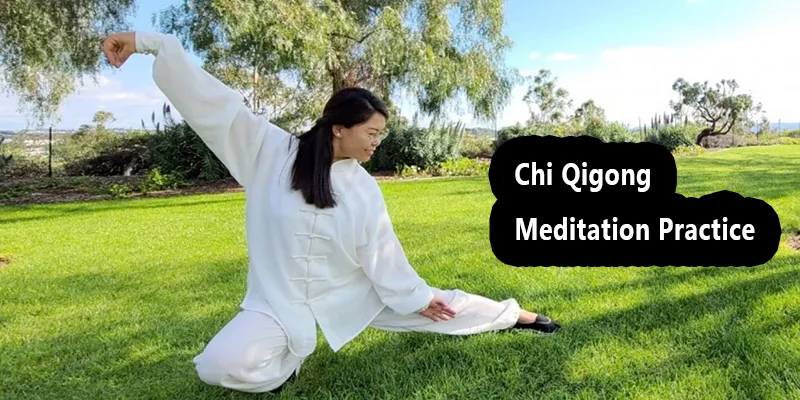
How They Work Together
Tai Chi’s graceful moves are synchronized with Qigong breathing techniques and meditative focus, creating a “moving meditation” that combines physical exercise, energy cultivation, and mental stillness. Qigong exercises activate the body’s energy system, while Tai Chi movements circulate Qi, and meditation anchors awareness to its flow.
Key Practices in Tai Chi Qigong Meditation
- Warm-Up Qigong Exercises: Slowly shaking or tapping to awaken energy.
- Dragon Stretches: Gently stretches to loosen muscles and meridians.
- Tai Chi-Qigong Forms
- Yun Shou: A flowing Tai Chi movement combined with Qigong breathwork.
- Tiān Zhì: A Qigong posture integrated into Tai Chi to draw energy from the earth and heavens.
- Zhan Zhuang: Strengthens the body’s energy field and mental focus.
- Hold static postures while focusing on breath and Qi circulation.
- Seated Qigong Meditation
- Sit quietly, using breathwork and visualization to guide Qi through the Dan Tian.
Tai Chi Meditation Composition
When you prepare for Tai Chi meditation, make sure you are in a comfortable environment. Turn off all mobile devices and anything else that might distract you. The quieter the better. The most common exercises in meditation include:
Preparation
Centering And Intention Setting
- Posture: Feet shoulder-width, knees slightly bent, arms relaxed.
- Breath: Natural breathing. Close eyes, soften gaze, or focus on a point ahead.
- Mindfulness: Ground through the feet. Set an intention (e.g., “calm,” “balance,” or “gratitude”).
Gentle Warm Up
- Neck/Shoulder Rolls: Loosen tension with slow circular motions.
- Spinal Waves: Sway gently forward/backward and side-to-side.
- Joint Rotations: Ankles, wrists, and hips.
Awakening the Breath
Breathing
- Place hands on the lower abdomen. Inhale deeply, expanding the belly; exhale fully, drawing navel toward the spine.
Breath and Arm Flow
- Inhale: Float arms upward to shoulder height.
- Exhale: Lower arms, releasing tension.
- Focus: Imagine moving through water—slow, fluid, and deliberate.
Practice Movement
Yun Shou
- Movement: Shift weight side-to-side, arms flowing in horizontal arcs.
- Inhale as arms rise, exhale as they descend.
- Mindfulness: Feel the transfer of energy through the palms.
Ye Ma Fen Zong
- Step forward, one arm guarding the chest, the other sweeping outward.
- Focus: Balance yin and yang energies.
Stillness in Motion
Zhan Zhuang
- Hold a standing meditation posture: arms rounded as if hugging a tree, knees soft.
- Breath: Slow, deep cycles. Imagine light filling the body.
Walking Meditation
- Step heel-to-toe with glacial slowness. Sync each step with breath.
- Inhale: Lift leg.
- Exhale: Place foot down.
- Mindfulness: Notice the earth’s support with each step.
Closing
- Stand quietly, hands at the dantian.
- Bow gently, honoring the practice. Whisper: “May this energy nourish myself and others.”
- Reach arms overhead, then fold forward into a soft hang. Breathe into the spine.
Tai Chi Meditation Methods
Tai Chi meditation combines slow, deliberate movements with breathing and mindfulness to unify body, mind, and spirit. Below are methods to deepen your practice:
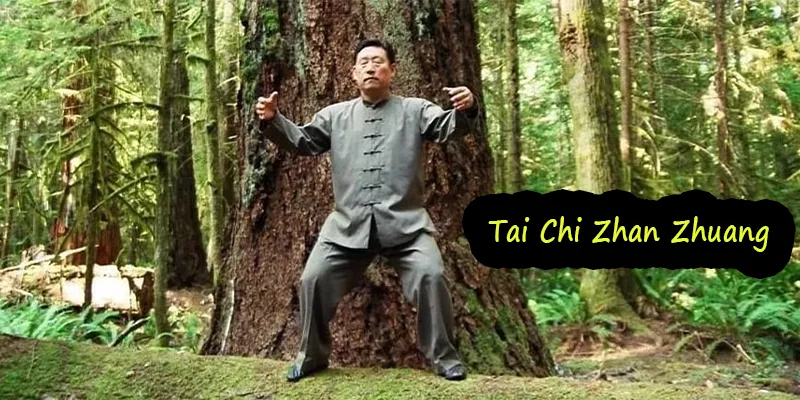
Zhan Zhuang
Feet shoulder-width, knees slightly bent, spine upright, arms relaxed at sides or curved as if “embracing a tree.” Breathe deeply into the lower abdomen. Focus on grounding through the feet while imagining energy rising from the earth.
Tai Chi Forms
Yun Shou shifts weight side-to-side while arms flow in horizontal arcs. Sync breath with motion (inhale rising, exhale sinking). Step gently while sweeping arms in fluid, circular patterns. Focus on smooth transitions and balance. Moving stepping, arm movements, and breath together to cultivate spatial awareness.
Chan Si Gong
Perform slow, spiraling movements with the arms, legs, and waist, as if “reeling silk from a cocoon.” Focus on initiating motion from the dantian (lower abdomen) and maintaining unbroken flow.
Key Insight: “Energy coils and releases like a spring.”
Tai Chi Stepping
Step heel-to-toe with exaggerated slowness. Sync each step with breath.
Seated Tai Chi Meditation
Sit cross-legged or on a chair, spine straight, hands resting on knees. Breathe naturally while focusing on the dantian. Observe thoughts and sensations without attachment, returning to breath.
FAQs
What is the difference between Qigong and Taichi?
Qigong primarily focuses on cultivating and balancing Qi through breathing, meditation, and gentle movements. It is often used for healing, stress relief, and energy enhancement. Qigong can be standing/sitting meditation or simple repetitive movements.
Tai Chi is a martial art that combines slow, flowing movements with internal energy work. Typically follows structured moves (forms, like the 24-form or Chen-style).
How to Learn Traditional Chinese Tai Chi Meditation?
If you want to learn traditional Chinese Tai Chi meditation, you must find an professional teacher.
Search online for master classes with a heritage or international certification, especially schools in Wudang Mountain, Shaolin or Chenjiagou in China. Start with basic exercises such as Zhanzhuang with abdominal breathing and gradually enter traditional Tai Chi meditation.
Is Tai Chi Better Than Meditation?
The question of whether Tai Chi is “better” than meditation depends on your goals and needs.
- When is Tai Chi “Better”?
- You want physical and mental benefits – Tai Chi improves balance, joint health, and muscle tone while also calming the mind.
- You struggle with sitting still – The gentle movements make it easier for restless minds to focus.
- You prefer structured practice – Tai Chi forms (like the 24-form) provide a clear routine.
- You’re interested in martial arts or Qi cultivation – Tai Chi has deeper energy work and self-defense roots.
- When is Meditation “Better”?
- You need deep mental relaxation – Sitting meditation can lead to deeper stillness.
- You have limited mobility – Meditation requires no physical effort.
- You want a quick, portable practice – Meditation can be done anywhere, anytime.
- You focus on spiritual growth – Some meditation styles (Zen, Kundalini) explore consciousness more deeply.


